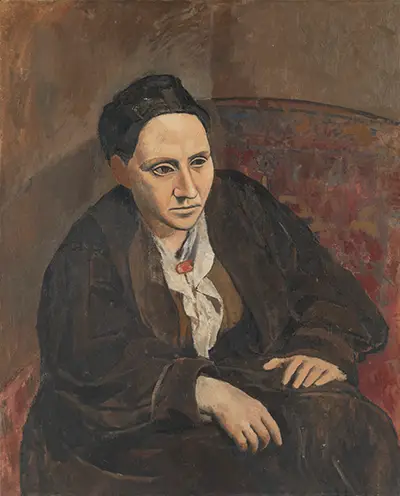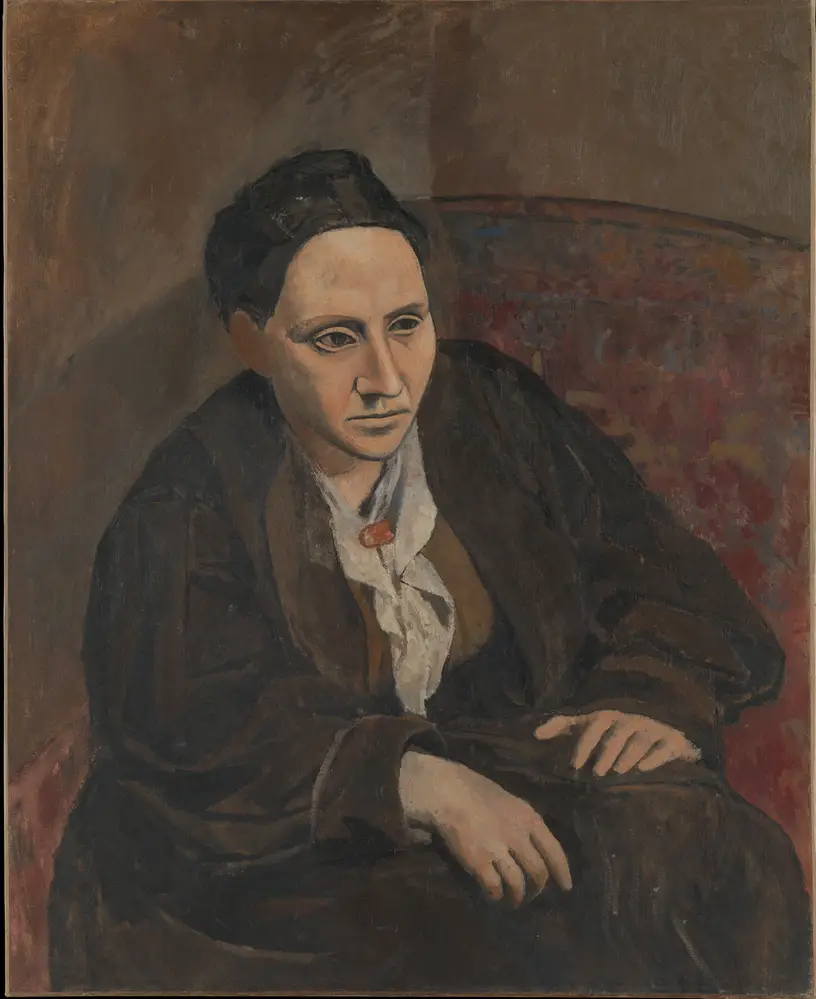This oil on canvas marked a significant change in the direction of portrait painting. Completed in 1906, the subject sat for the artist a reported 80 or 90 times – although this is believed by some to be an exaggeration – before he painted over the face and abandoned the work declaring 'I cannot see you any longer'. Picasso returned to the canvas one year later, and completed the portrait quickly without further sittings. Despite criticism from many who thought the painting didn’t look like Stein, she liked her portrait and kept it until her death in 1946 when she bequeathed it specifically to the Metropolitan Museum of Art where it still hangs. Gertrude Stein was an American writer born in 1874 who moved to Paris in 1903 with her brothers. The family collected art, especially works by Henri Matisse, and they set up a literary salon in the French capital that was very popular amongst the literary elite.
The salon was a meeting place for people such as Ernest Hemingway, F. Scott Fitzgerald and Matisse as well as other influential figures of the arts. Stein was also introduced to Alice Toklas at the salon in 1907 and the two became partners soon after. The pair were inseparable for the rest of their lives, and Stein even wrote a book about her partner. Picasso, originally from Malaga in Spain, moved to Paris in 1904 and met Stein just one year later when she was 30 and he 24, and a close friendship was soon established. She commissioned her portrait not long after they met, and Pablo Picasso was excited and keen to capture her formidable personality. The Portrait of Gertrude Stein is important because it demonstrates signs of the initial beginnings of Cubism – the art style which is attributed to Pablo Picasso as part of a small group.
Cubism was founded in 1907 by Picasso and Georges Braque and is an abstract style using geometric shapes and showing several views of a person or object in a single painting. In the Stein portrait, the body has been painted in a more natural style, with some details picked out in the fabric of the chair, but in contrast the face stands out due to its mask-like quality. There are elements of slight distortion in the face, one side looking as though it is captured from a different view point, demonstrating early beginnings of the Cubism style that is to follow. The face in the painting is smooth, with dark outlines around the eyes; these are characteristics that get carried through to Picasso's later paintings. He produced whole bodies of work in particularly styles over periods of several years before then moving ever onwards to a new creative challenge, encompassing items such as the Purple, Blue, Cubist and more traditional earlier periods.
In Demoiselles D'Avignon, for example, the two central figures have the same outlined eyes and the simple eyebrows look similar to the Stein portrait. In fact the hair also looks identical in both of these paintings - scraped back in a bun and placed on top of the head almost like a hat. Looking at the painting as a whole, Picasso highlights some of the Stein's well-known personality traits in this portrait. The subject is seated in a strong, more masculine pose. She is leaning forward and filling the canvas and the viewer gets the feeling that this is a sturdy woman who is powerful and confident. Although she looks serious, there is no feeling of anger in the piece, in fact the painting seems positive in its emotion. These are the attributes of Stein that Picasso wanted to capture and share with his audience, and the ones the sitter was most pleased with.
The model herself looks entirely stern in the way she focuses her eyes in an intense manner just to the right of where we are viewing the piece. A direct gaze at us would have given off a much more aggressive tone and perhaps was not what the artist desired. Instead, we are not the target, but perhaps the artist himself or instead she has simply been asked to angle her expression in this way. Her clothing is formal and relatively hard wearing, rather than fashionable. She wears no makeup at all and her hair is styled in a practical rather than pretty way. She oozes unhappiness with the world, perhaps at the tasks she has to carry out all day and the lack of appreciation that she receives in return. The room itself, although only briefly featured, continues this style of darkness in colour and mood. This Portrait of Gertrude Stein helps to remind us of the artist's ability to capture different tones and moods across his career and how they would often be reflecting his own inner status at the time. It is hard to imagine someone full of the joys of life choosing to work in this way at that point, but later on we did see a far more positive artist and it is perhaps this one which has helped him to become so popular across so many different generations.
This painting which stands at around one metre in length can now be found at the Metropolitan Museum of Art in New York City, United States. It remains one of the best art collections in the whole of the United States and has plenty more to see besides just this portrait of Gertrude Stein, as wonderful and intruiging as it is. They also go much wider than just art, with all manner of other historical items from a wide variety of different civilisations to be found here. The Adoration of the Magi by Giotto di Bondone, Joséphine-Éléonore-Marie-Pauline de Galard de Brassac de Béarn (1825–1860), Princesse de Broglie by Jean Auguste Dominique Ingres and At the Seaside by William Merritt Chase are amongst our personal favourites to be found here. There is enough to surely please pretty much any taste and this venue remains amongst the most visited in the whole country, consistently adding to its collection every year.



